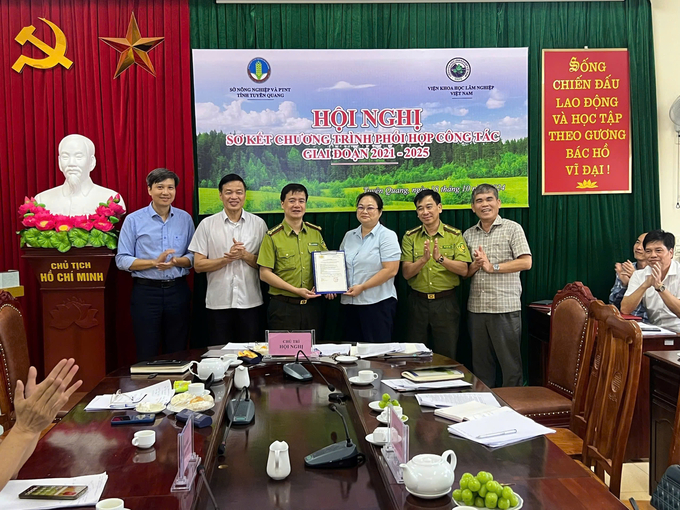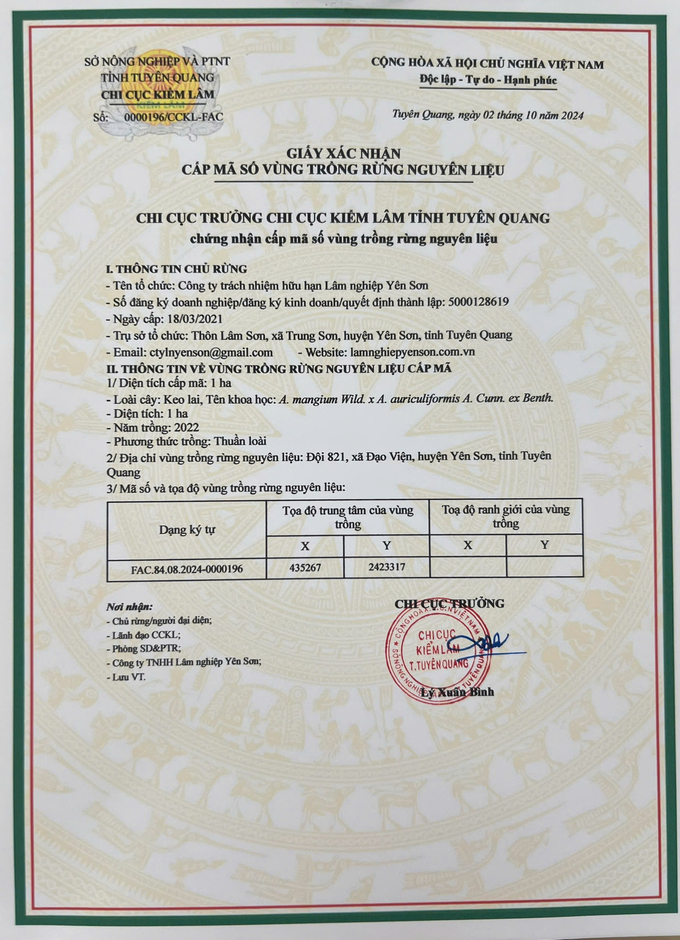June 19, 2025 | 00:22 GMT +7
June 19, 2025 | 00:22 GMT +7
Hotline: 0913.378.918
June 19, 2025 | 00:22 GMT +7
Hotline: 0913.378.918

Tuyen Quang Provincial Forest Protection Department awarded certification of forest production unit code. Photo: Bao Thang.
The Vietnamese Academy of Forest Science (VAFS) has just coordinated with the Department of Agriculture and Rural Development of Tuyen Quang province to grant a forest production unit code certificate for raw materials to Yen Son Forestry Company Limited at the 3-year review conference of the 2021-2025 Cooperation Program between the two units.
The code granted covers an area of 1ha, planted with pure hybrid acacia since 2022, in the raw material forest planting area of Team 821, Dao Vien commune, Yen Son district. Information on the planting area coordinates is accurately determined by the iTwood System and certified by the Tuyen Quang Provincial Forest Protection Department.
It is the first forest production unit code granted to forest owners in Vietnam, within the program piloted by the Ministry of Agriculture and Rural Development in 5 provinces: Bac Giang, Lang Son, Phu Tho, Tuyen Quang, and Yen Bai.
As of October 20, the total area of planted forests registered by forest owners in the program for land use rights to be granted codes was up to 3,500 hectares in Tuyen Quang, of which 1,366 hectares of planted forests belonged to Yen Son Forestry Company Limited and 958 hectares of planted forests in 5 communes of Yen Son district.
"The issuance of forest production unit codes contributes to information transparency, promoting the export of wood and forest products," said Mai Thi Hoan, Deputy Director of the Department of Agriculture and Rural Development of Tuyen Quang, hoping that, combined with the project to build Tuyen Quang into a high-tech forestry area, the locality will become a forestry development pole in the North.
The foundation for issuing forest production unit codes is the iTwood system, a tool to support real-time wood supply chain management. Each stage in the profile creation process will be granted a QR code, ensuring a continuous flow of information on the legality of raw wood from the stages of forest planting - exploitation - wood trade.

Certificate of forest production unit code.
Thanks to the cloud computing model, iTwood supports users to trace the origin of wood quickly. Dr. Hoang Lien Son, Director of the Center for Forestry Economics Research, shared: "The issuance of forest production unit code integrated on the iTwood system with other functions will continue to be expanded during use, best to support forest owners and wood processing and trading enterprises".
From the 5 initial pilot provinces, in Yen Bai, Phu Tho, Tuyen Quang, Bac Giang, Lang Son, and the expanded pilot application in Ca Mau, Dong Nai, Binh Dinh, Quang Nam, Quang Tri, the iTwood system has created an input database for the wood industry nationwide, contributing to transparency and development of e-commerce transactions for wood products. The area registered for planting area codes of all these provinces has reached 67,000 hectares.
On the beneficiary side, forest owners have urgently implemented many measures since the beginning of 2024, such as training to improve forest management capacity, building detailed maps of forests, including coordinates, area, current status of planted forests, etc.
With the support of management agencies, professional agencies, and scientists, businesses have realized that applying dynamic QR Code technology to trace origin brings many long-term benefits. Firstly, the competitiveness of products with traceability labels will be higher than that of similar products. Secondly, dynamic QR Code technology allows the creation of QR code stickers for wood products to fully trace information about the forest planting area and the place of commercial processing of wood products, helping to affirm transparency and prestige in building a trustworthy image in the hearts of consumers.
Currently, Yen Son Forestry Company Limited is also promoting the issuance and management of planting area codes to create and develop a legal and traceable wood supply chain, promoting sustainable forest management and FSC certification.
Analyzing this issue further, Prof. Dr. Vo Dai Hai, Director of VAFS, said that when forest production unit codes are assigned to wood lots entering the supply chain, the organization and development of a legal wood supply chain and traceability will be more convenient, cost less, creating a digital platform for production and business database of planted forests, digital transformation, strong connection with the market and improving production and business efficiency.
Granting planting area codes is an important requirement to make transparent information about the origin of products and the technology used to create those products. This is one of the mandatory requirements in the context of international integration and participation in the global supply chain.
In Vietnam, the granting of planting area codes for agricultural crops has been implemented according to the Law on Cultivation 2018 and Decision 3156/QD-BNN-TT dated August 19, 2022 of the Minister of Agriculture and Rural Development. Thanks to this legal corridor, many agricultural products, especially fruits, have increased in export in recent years.

Survey to collect information on granting forest production unit codes in Tuyen Quang province. Photo: VAFS.
For forestry, the issue of wood traceability was raised quite early, according to the provisions of the Agreement between the Government of Vietnam and the Government of the United States on Illegal logging and timber trafficking (Section 301 of the US Trade Act of 1974) and the Agreement on Controlling Logging Activities signed on October 1, 2021.
For the EU, Vietnam also participates in the Voluntary Partnership Agreement (VPA) and is implementing the construction of the VNTLAS timber legality assurance system. Most recently, the European Commission adopted the EU Deforestation Regulation (EUDR) on December 6, 2022. Accordingly, enterprises producing and using raw wood for processing must build and develop a legal timber supply chain that does not cause deforestation. This is a mandatory requirement for exporting goods to the EU.
In addition, other export markets for wood and wood products from Vietnam, such as Japan, Korea, China, etc., also require strict control and traceability of wood origin. “From these facts, it can be seen that the issuance of forest production unit codes in the current context in Vietnam is extremely necessary and urgent,” said Prof. Dr. Vo Dai Hai.
Deputy Minister of Agriculture and Rural Development Nguyen Quoc Tri has promptly directed the Forestry Department and VAFS to study the experience of issuing codes for agricultural crop growing areas to digitize the process of issuing codes for forest growing areas, moving towards building a database to manage all forest resources in Vietnam.
Based on Decision No. 2260/QD-BNN-LN dated July 9, 2024, the Forestry Department and VAFS will implement the task in 2 phases: The pilot phase, within 24 months, will issue temporary guidance documents on the issuance and management of forest production unit codes for raw materials to draw experience and perfecting the system of legal documents, before expanding nationwide.
Phase two, from 2026 onwards, the process of issuing and managing forest production unit codes will be implemented nationwide.
After nearly 4 months of active participation, with high determination towards sustainable forestry development, as well as completing the goals and tasks of the industry in 2024, the Forestry Department, Department of Agriculture and Rural Development, Forest Protection Sub-Department, local authorities, businesses and people in 5 pilot provinces have had the first forest production unit codes.
Translated by Huong Giang
![Turning wind and rain into action: [9] Digitizing hydrometeorological data in response to climate change](https://t.ex-cdn.com/nongnghiepmoitruong.vn/608w/files/news/2025/06/17/z6704423696987_15fd32ffc26d590d204d520c9dac6786-nongnghiep-165943.jpg)
(VAN) Farmers have begun accessing hydrometeorological applications to adjust their cropping schedules, aiming to ensure productivity and adapt to climate change.
![Turning wind and rain into action: [8] Real-time salinity detection and early warning technology](https://t.ex-cdn.com/nongnghiepmoitruong.vn/608w/files/news/2025/06/17/z6704423696987_15fd32ffc26d590d204d520c9dac6786-nongnghiep-151127.jpg)
(VAN) Thanks to the integration of modern hydrological-hydraulic models, remote sensing technologies, and artificial intelligence, the accuracy of hydrological forecasting has significantly improved.
![Turning wind and rain into action: [7] Early disaster warnings help marine farmers minimize losses](https://t.ex-cdn.com/nongnghiepmoitruong.vn/608w/files/news/2025/06/17/z6704423696987_15fd32ffc26d590d204d520c9dac6786-nongnghiep-142942.jpg)
(VAN) In recent years, thanks to early disaster warnings and forecasting, marine farmers in Khanh Hoa province have been able to reduce risks and losses, thereby improving production efficiency.
![Turning wind and rain into action: [6] ‘Four on-the-spot’ disaster management software](https://t.ex-cdn.com/nongnghiepmoitruong.vn/608w/files/news/2025/06/17/e5a48259d6a262fc3bb3-nongnghiep-183800.jpg)
(VAN) By simply activating the scenario on the disaster management software, the relevant authorities immediately know how many households need to be evacuated, where to evacuate them to, and by what means of transportation…
![Turning wind and rain into action: [5] Hue applies modern technology in disaster forecasting](https://t.ex-cdn.com/nongnghiepmoitruong.vn/608w/files/news/2025/06/17/z6704423696987_15fd32ffc26d590d204d520c9dac6786-nongnghiep-093938.jpg)
(VAN) In Hue city, modern technology has recently been applied in meteorological and hydrological forecasting and warning, helping to reduce the damage caused by natural disasters.

(VAN) A cutting-edge farming technique being implemented on an experimental ranch in Arizona's Sonoran Desert has already saved a billion gallons of water over five years, according to Civil Eats.

(VAN) Poultry and pig production and the environment can be boosted through enhanced water technology, according to new research.